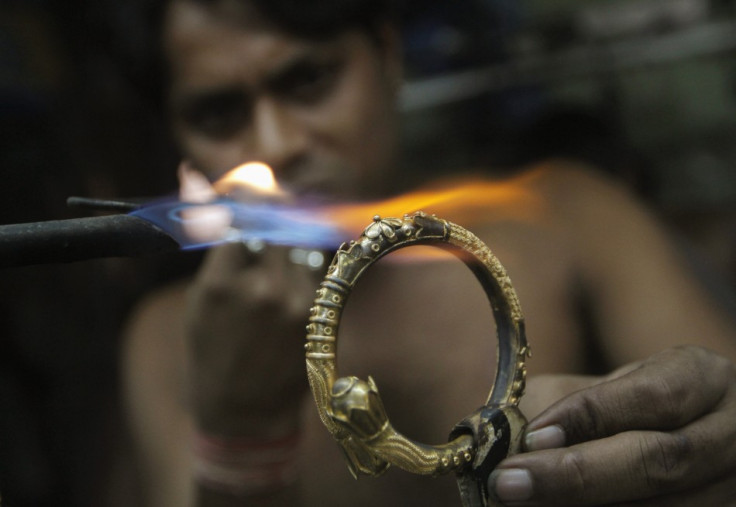In India, Gold is Still the Best Bet, Driving World Market

Rumours in Mumbai's Zaveri Bazar, a bee-hive of gold traders, point to how Indians bought some 24 tons of gold on a single day, on 13 May this year, the day of the Akshaya Tritiya festival when gold buying turns auspicious, an official with The Bombay Bullion Association said.
Falling gold prices triggered a buying spree across India during April and May. Gold was at its volatile worst on 16 April when it hit a two-year low of $1,321.95 and traders blame London for sparking a sell-off that ultimately benefited the US.
Two theories emerge on volatility: The first, pointed to London. The price of gold is decided, twice, each business day in London by members of The London Gold Market Fixing. These prices have served as a benchmark the world over.
The five members are The Bank of Nova Scotia - Scotia Mocatta, HSBC, Deutsche Bank AG London, Societe Generale Corporate & Investment Banking and Barclays Capital.
"Word of mouth goes that on the morning of 11 April, just before the price was fixed, one of the members intimated The London Gold Market Fixing that they were planning to sell a large quantity gold that day. Other members pondered as to whether to sell or not.
While we do not know which member first decided to sell or how much they sold, the markets picked the information up and everybody including exchange-traded funds wanted to sell," said The Bombay Bullion Association's Secretary Surendra Mehta.
"We cannot tell for sure as to who is playing the market but it is evident that the ultimate beneficiary is the US. When your dependency on gold comes down, because your are selling, your dependency on the US dollar goes up, benefiting the US economy," Mehta said.
Global macro data is another pointer. There has been a lot of selling pressure on gold in the past one month, partly induced by some central banks in Europe talking of raising funds through gold sales, said Ravi Singh, who heads commodities research at stock broking firm SMC Global Securities.
When a central bank, which usually has a long-term view, talks of selling gold, it could trigger panic selling in the market. "But growth data from the major economies of the world shows that things are improving and gold will become less attractive soon," Singh said.
In India, Rajesh Exports, the top manufacturer and exporter of jewellery, told Bloomberg that sales at their 75 retail outlets could have jumped 40% year-on-year on the Akshaya Tritiya day.
The Bombay Bullion Association (BBA), which runs one of the oldest gold melting facilities in Zaveri Bazar, catering to 700 BBA members, expected sales to hover around four tons on 13 May. "The rumours are that some 24 tons of gold was bought on the Akshaya Tritiya day in India. I cannot confirm this but I think the sales number being thrown around includes gold exchange-traded funds (ETFs)," Mehta said.
The 13 May buying spree is uncommon because gold had never been more affordable. When global prices fell 17% over a two-week period in April, imports of gold and silver into India sky-rocketed 138% year-on-year, to $7.5bn. Women drive purchases in India where households held about 20,000 tons of gold last calendar year, the World Gold Council estimated, valued at $1.16 trillion back then. Simply put, this translates to 50% of India's GDP.
Historically, India has been the largest consumer of gold and it is forced to import it because it hardly produces any. Gold imports have risen threefold, to $61.5bn in the 2011-12 financial year, according to a YES Bank report.
India's wider trade gap in April was due to a surge in gold and silver imports that month. The gold rush widened India's trade deficit by 72% to $17.8bn.
Industry is now worried that government controls will force many to smuggle gold into the country to meet demand.
"India's attachment to gold will not change. The government cannot change this. Higher import duties, local taxes and government restrictions would only increase the illegal import of gold," Mehta said. Last year, 102 tons of gold, or 10% of all imports, was smuggled into India and this could rise 40% this year, to 140 tons, according to a statement from Thomson Reuters GFMS.
Making sense of present-day India's lust for gold is not difficult. People believe that investing in gold is more lucrative than investing in real estate or in financial products, hardly understood by small towns in the south Asian country.
"Gold, in India, is not a consumption item but an investment. It drives economic activity at the lower end (of the social strata) and is easier to understand when compared to some banking products. There are no financial instruments that can give you the same level of comfort or security," said Somasundaram P R, the World Gold Council's managing director for India.
© Copyright IBTimes 2025. All rights reserved.




















